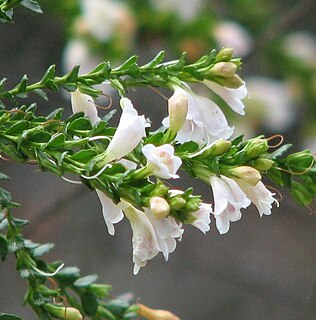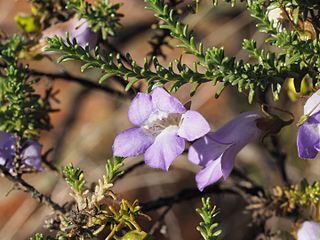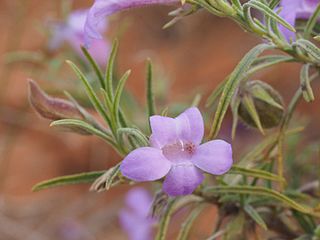
Eremophila oldfieldii, commonly known as pixie bush, is a flowering plant in the figwort family, Scrophulariaceae and is endemic to Western Australia. It is a shrub or small tree with rough bark, broad, flat or narrow fleshy leaves and red, orange or yellow flowers.

Eremophila bowmanii, also known as silver turkeybush, Bowman's poverty bush and flannel bush, is a flowering plant in the figwort family, Scrophulariaceae and is endemic to New South Wales and Queensland in Australia. It is a low to medium, spreading shrub with silvery-grey, hairy foliage and blue to lilac flowers, and sometimes grows in dense thickets with mulga.
Eremophila eriocalyx, commonly known as desert pride, is a flowering plant in the figwort family, Scrophulariaceae and is endemic to Western Australia. It is an erect shrub with greyish leaves, very hairy sepals and petals that range in colour from white to yellow, sometimes pink or purple.

Eremophila dichroantha, also known as bale-hook eremophila, is a flowering plant in the figwort family, Scrophulariaceae and is endemic to the south-west of Western Australia. It is a shrub with many ascending branches making the plant appear broom-like. It has small, hooked leaves and small, though abundant, violet to lilac-coloured flowers.

Eremophila clarkei, commonly known as turpentine bush, is a flowering plant in the figwort family, Scrophulariaceae and is endemic to Western Australia, South Australia and the Northern Territory. It is a shrub which is variable in form, but usually with narrow leaves and white or pale pink flowers. It is similar to Eremophila georgei and Eremophila granitica.

Eremophila fraseri, commonly known as burra or jilarnu, is a flowering plant in the figwort family, Scrophulariaceae and is endemic to Western Australia. It is a shrub or small tree with all above-ground parts of the plant, apart from the petals, sticky and shiny due to the presence of a large amount of resin. The petals are coloured white, cream, pink and brown.

Eremophila brevifolia, also known as spotted eremophila, is a flowering plant in the figwort family, Scrophulariaceae and is endemic to the south-west of Western Australia. It is an erect, open, spindly shrub with sticky, short, serrated leaves and white to pink flowers and is only known from a few scattered populations.

Eremophila mackinlayi, commonly known as desert pride, is a flowering plant in the figwort family, Scrophulariaceae and is endemic to Western Australia. It is a shrub with its branches and leaves covered with a thick layer of yellow to grey hairs, mostly egg-shaped leaves and deep lilac-coloured to purple flowers. It is most closely related to E. strongylophylla and E. hygrophana and sometimes occurs in the same areas as these species.

Eremophila strongylophylla is a flowering plant in the figwort family, Scrophulariaceae and is endemic to Western Australia. It is a small shrub with distinctive round leaves, yellowish new growth and purple flowers which are white inside. It is similar to Eremophila mackinlayi and Eremophila hygrophana but distinguished from them by characteristics including leaf shape, and the type of hairs on its leaves and branches.

Eremophila christophori, commonly known as dolomite fuchsia bush, is a flowering plant in the figwort family, Scrophulariaceae and is endemic to the southern part of the Northern Territory in Australia. It is an erect shrub with bright green leaves and white, pink or lilac flowers.

Eremophila densifolia is a flowering plant in the figwort family, Scrophulariaceae and is endemic to the south-west of Western Australia. It is usually a low, spreading shrub with densely clustered leaves and lilac to purple flowers.

Eremophila drummondii, commonly known as Drummond's eremophila, is a flowering plant in the figwort family, Scrophulariaceae and is endemic to the south-west of Western Australia. It is a variable shrub, usually with sticky branches and leaves, long, thin leaves and mauve or purple flowers in spring.

Eremophila exilifolia is a flowering plant in the figwort family, Scrophulariaceae and is endemic to Western Australia. It is a widely distributed shrub which is shaped like an inverted cone and has small, very sticky leaves and branches and lilac-coloured flowers.

Eremophila gibsonii is a flowering plant in the figwort family, Scrophulariaceae and is endemic to Australia. It is a sticky, glabrous, rounded shrub with narrow leaves and white to lilac-coloured flowers and which occurs in Western Australia, South Australia and the Northern Territory.

Eremophila gilesii, commonly known Charleville turkey bush, green turkey bush, desert fuchsia and Giles emu bush is a flowering plant in the figwort family, Scrophulariaceae and is endemic to Australia. It is usually a low, spreading shrub with pinkish-lilac to purple flowers and is widespread in the Northern Territory and all mainland states except Victoria. It is considered a difficult agricultural weed in some parts of Queensland but is often used as a bush medicine by Aboriginal people.

Eremophila ionantha is a flowering plant in the figwort family, Scrophulariaceae and is endemic to Western Australia. It is a shrub with many sticky branches, narrow, light green leaves and blue, purple or violet flowers.
Eremophila petrophila is a flowering plant in the figwort family, Scrophulariaceae and is endemic to Western Australia. It is a tall, erect, open shrub with rough branches, narrow, sticky leaves and pale lilac-coloured flowers.

Eremophila psilocalyx is a flowering plant in the figwort family, Scrophulariaceae and is endemic to Western Australia. It is an erect shrub with a broom-like shape, narrow, hooked leaves and white, pink, blue or purple flowers. It is common in the mallee country around Esperance. It was sometimes incorrectly known as Eremophila pachyphylla.

Eremophila rotundifolia is a flowering plant in the figwort family, Scrophulariaceae and is endemic to Australia. It is a shrub with many tangled branches with its leaves and branches covered with a layer of silvery-grey hairs. Its flowers range in colour from pale to deep lilac. It is common in South Australia and there is also a single record from the Northern Territory.

Eremophila willsii is a flowering plant in the figwort family, Scrophulariaceae and is endemic to Australia. It is an erect shrub with bright green, often serrated leaves and pinkish to deep pinkish-purple petals. It is mainly found in Western Australia, the Northern Territory and South Australia in deep sand.

















